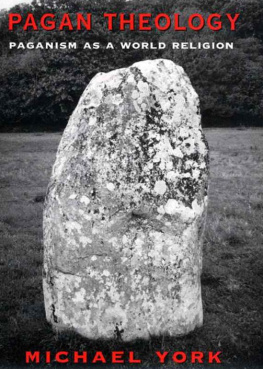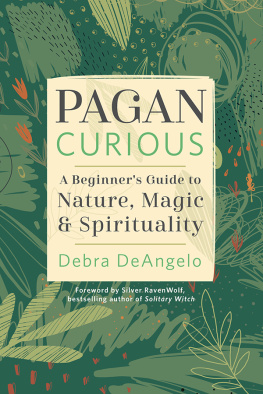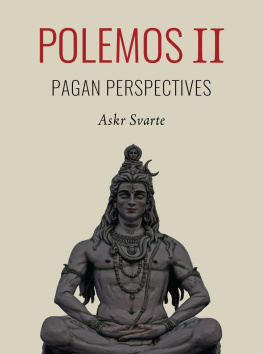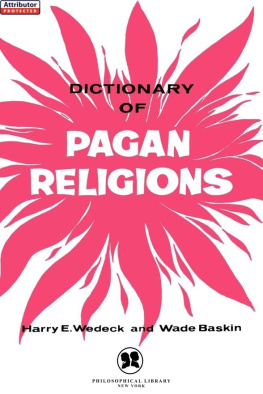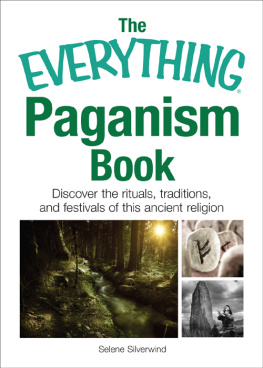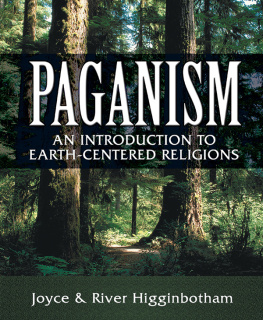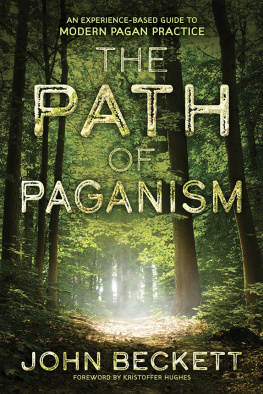Pagan Theology
Pagan Theology
Paganism as a World Religion
Michael York

NEW YORK UNIVERSITY PRESS
New York and London
2003 by New York University
All rights reserved.
Library of Congress Cataloging-in-Publication Data
York, Michael, 1939
Pagan theology : paganism as a world religion / Michael York.
p. cm.
Includes bibliographical references.
ISBN 0-8147-9702-4 (alk. paper)
1. Religions. 2. Paganism. I. Title.
BL85 .Y67 2003
299dc21 2002151073
New York University Press books are printed on acid-free paper,
and their binding materials are chosen for strength and durability.
Manufactured in the United States of America
10 9 8 7 6 5 4 3 2 1
Contents
Preface
Witches and neopagans are increasingly becoming fixtures on American campuses, especially the contemporary liberal university alleged to foster destructive experimentation with personal identity. The associate provost of Boston University, Peter Wood, for example, does not find neopagans particularly dangerous but simply confused, deluded, frivolous, and devoid of intellectual seriousness. Little inanities that once would have been brushed aside [by campus clergy] now settle in as opportunistic infections. For critics like Wood, paganism is little more than a jumble of magical formulas and invocations to miscellaneous gods and goddesses that should be distinguished from the ethical guidance offered by Christianity, Judaism, Islam, and Buddhism. In Woods view, contemporary paganism is a movement that disdains any goal of intellectual coherence, and he questions its position in a university community.
In a vote at Boston University among legitimate campus religious groups, the witches were cast out, allowing Wood to feel that in this case simple piety triumphed over the idol of Diversity that is otherwise increasingly becoming the prevailing politically correct ideology. But despite the Boston University clergys retroaction, paganism is frequently cited as one of the fastest-growing spiritual orientations, at least in the West. While many reasons may be furnished as to why this is so (the ecological threat to the planet, a popular emergence of antiauthoritarian spirituality, or part of the information revolution itself), the question remains whether paganism can be in any way considered serious religion.
The answer to this question is the purpose of this book. Part of the answer is to situate paganism as a world religion, that is, as a legitimate spiritual perspective that already exists globally. While the numbers of people who adhere to pagan religion may not be as numerically significant as those who follow the teachings of Christ, Muhammad, or Gautama Buddha, their numbers are still impressive. Although many, if not most, of them do not use the word pagan to describe their beliefs or practices, I contend that they hold an identifiable position of common characteristics and understandings for which the label pagan is feasible and debatably accurate.
Besides examining these particular pagan religiosities, I also explore paganism as a general form of religious behavior. To this end, I survey some of the other major world religions to identify the kind of spontaneous ritual veneration that can be interpreted as pagan. My aim is to show the pagan affinity of spiritual behavior that might be seen as integral to human nature. I then conclude with a theological analysis that distinguishes between paganism and gnosticism as essential spiritual ideal types that differentiate most religious activity. This means that I examine paganism as, successively, a religion, behavior, and theology.
To situate paganism as a theological religion and a religious behavior, we must first understand what religion is. This question is a vexing and contentious one. Despite the complexities and disagreements that the issue raises, it still is a necessary question to ask when considering whether any spiritual practice or affirmation is actually religious or whether its expression constitutes a religion. Here I contend that paganism represents what I term a root religion and that historically all other religions are off-shoots and/or counterdevelopments of the root religion. Consequently, if we wish to understand any religion, we must also understand paganism as the root from which it grew. The irony in this understanding is that it precludes recognizing a root religion as being religious.
In , I conclude with a delineation of generic paganism from a theological perspective. I hope in this endeavor to establish the concept of paganism as a useful designation for an important religious perspective. In so doing, the advantage is not only the recognition of a marginal position but also the authentication of the basic differences among the religions themselves. My reason for doing this is not to create a religious threat to established world religions but to make clearer the integral self-sufficiency of each religion.
I would like to make clear that this book is in no way meant to be an encyclopedic presentation of religions. Rather, it is aimed at developing an understanding of what paganism is or at least could be understood to be. To this end, the book is part confessional, part apologetic, and part sociological. If I had to name my own denominational predilection, I would say that I am a religionist. I believe in religion itself and its central role in expanding human consciousness above and beyond immediate daily concerns. In its overall, collective sense, I see religion as an ongoing dialogue that questions the purpose of life and our terrestrial incarnations. In my own pursuit and love of religion as religion, I have been particularly attracted to paganism not only as the source and origin of all religion but also as an organic alternative to the institutionalized authority and parochial insularity that much religious expression has become.
With regard to religions more globally, much of my direct experience of faiths beyond the Judeo-Christian tradition has been in the Far East: in India, Nepal, Thailand, China, and Japan. It is for this reason that my investigation into formulating an understanding of paganism draws particularly from these areas. In regard to other areas on which I have drawn for this book, my direct observation has been more limited. I recognize that this portends a deficiency from the start, but here I am searching for salient features that might support my thesis. These areas are, therefore, supplemental and not intended to be exhaustive. For tribal religions and especially for an awareness of Islam, I am more dependent on secondary sources, although I have nevertheless been able to benefit to some extent from direct experience in Muslim countries through visits to Morocco, Turkey, Pakistan, Bangladesh, Egypt, and India (which contains the worlds second largest Muslim population).
I also have been involved in Native American studies since 1960. But with regard to sub-Saharan Africa, I am confined at present to two visits to South Africa, in 1999 and 2000. Consequently, I am particularly indebted to my colleagues in the Department for the Study of Religions at Bath Spa University College, namely, Richard Hoskins for suggestions concerning anthropological studies of African religion and Jo Backus for Aboriginal and Maori studies. Denise Cush and Mahinda Degale have assisted in the area of Buddhism; Catherine Robinson, in that of Hinduism. I would also like to acknowledge and thank my many colleagues who contribute regularly to the Nature Religions Scholars list: Chas Clifton, Bron Taylor, Jeff Kaplan, Wendy Griffin, Macha Nightmare, Tanice Folz, Gus diZerega, Barbara A. McGraw, Christiellen White, Fritz Muntean, Grant Potts, Doug Ezzy, Lucie DuFresne, Vivianne Crowley, Shawn Arthur, Cat Chapin-Bishop, Kirk White, Sian Reid, Barb Davy, Adrian Ivakhiv, Adrian Harris, Jenny Blain, MJ Patterson, Jo Pearson, Shelley Rabinovitch, Eric Jette, Francine Nicholson, Jone Salomonsen, Sheri Morton Stanley, Laura A. Wildman, Dave Green, Brendan Cathbad Myers, Sarah Pike, Morgan S. Davis, Craig S. Strobel, Eylon Israeli, Marilyn R. Pukkila, John Bauman, Grove Harris, Nancy Ramsey Tosh, and Michael Strmiska, to name only the barest few.
Next page
